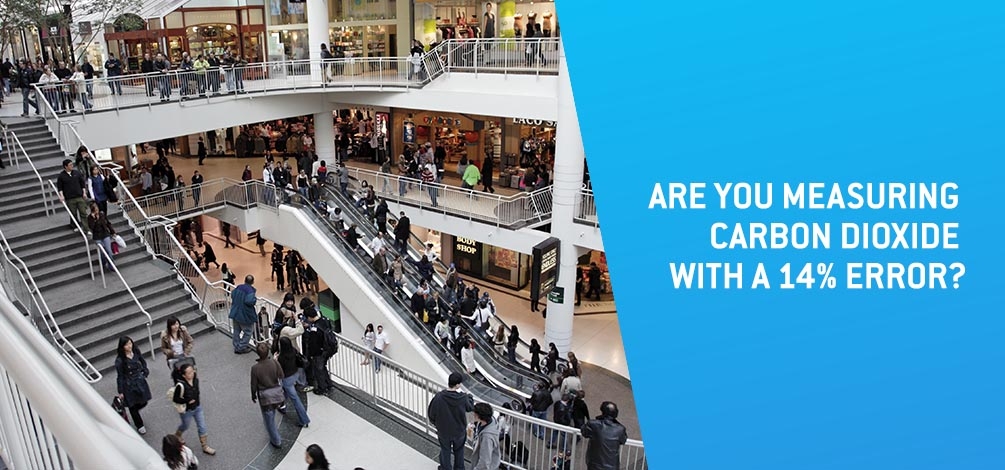ARE YOU MEASURING CARBON DIOXIDE WITH A 14% ERROR?

Researchers concluded that inhaling carbon dioxide at high levels, may dilate brain blood vessels, reducing neuronal activity.
Researchers concluded that inhaling carbon dioxide at high levels, may dilate brain blood vessels, reducing neuronal activity and triggering the consequent decreasing of communication quality between different brain regions.
A study performed in 2017, The Ventilation problem in schools, by W.J. Fisk, revealed that, by increasing school’s ventilation, children can achieve better results and perform all the tasks quickly, avoiding distraction moments.
In this way, carbon dioxide levels measurement equipment are essential tools to ensure the correct ventilation, by monitoring carbon dioxide levels and communication with ventilation systems, performing level readings throughout the day, to ensure the best practices that ensure the high performance of professionals in meeting rooms, offices, or business intelligence, to ensure the fastest and best purchase decisions in retail or shopping centers, increasing likelihood better results.
However, the use of data collection and monitoring equipment requires an in-depth knowledge of measurement methodologies, variables interpretation and other variables that may impact the collected data quality.
Carbon dioxide sensors use a Non-Dispersive Infrared (NDIR) technology. Although this technology is effective, attending to gas measurement, it is directly related to the atmospheric pressure and temperature at which sensor is at the time of measurement.
Considering an air volume whose dioxide concentration is 1000ppm(parts/million), this air volume consists in the mixture of 999 000 air molecules and 1000 carbon dioxide molecules. However, the volume needed to hold this same number of particles depends on atmospheric pressure and air temperature.
As altitude increases, atmospheric pressure decreases. The atmospheric pressure decreasing makes the air more rarefied, and for the same air volume, there will be fewer molecules. The fact that it contains fewer molecules doesn’t mean that carbon dioxide concentration decreases, keeping unchanged the factor between carbon dioxide molecules and air.
Temperature increase also triggers a similar behaviour too. With a higher temperature or a lower atmospheric pressure there will be less air molecules in the sample chamber, so there will also be fewer CO2 molecules, although CO2 concentration hasn’t decreased in PPM.
That way few carbon dioxide molecules mask the sensor readings leading to a lower carbon dioxide concentration than exists because sensors consider a standard atmospheric pressure at 1013mbar.
Since the dependence of the density of air molecules depends on two facts, temperature and atmospheric pressure, is not possible to compensate the acquisition only from one of them. Since atmospheric pressure is directly related with altitude, although it doesn’t depend exclusively on altitude, it is possible to reduce it from altitude, including the temperature influence on a single expression. Note that at sea level, 0m altitude, temperature has no effect on atmospheric pressure. The calculation of atmospheric pressure value is directly related to altitude and temperature variation.
On other side, when featured, the sensor acquisition dependency it is possible to compensate. For example, the probe used in DUOS CO2 transmitter presents an acquisition dependency, can be described by the following equation:

The probe dependency on atmospheric pressure can cause a substantial error.
For example, if the probe is installed in the Guarda city (1056m altitude), Portugal, at 25ºC temperature, the site atmospheric pressure will be approximately 900mbar, following a physical calculation formula.
Considering that the value measured by the probe is 1000pp, the acquisition error is calculated by:

So, a 113mbar variation causes a -13.8% error in the probe acquisition.
The local atmospheric pressure is difficult to establish without additional tools. However, at which it is located is relatively simple, using, for example, a mobile phone with GPS technology.
Temperature is another variable required to the compensation available on the DUOS CO2 transmitter. Inserting the altitude value at which probe is installed, through the Tekon Configurator software, the transmitter has the necessary information to apply the calculation equation and thus obtain the atmospheric pressure to which the probe is subjected with a reduced error range. With this information can apply the calculation formula and perform the measurement compensation for each sample. Below example:

Carbon dioxide monitoring requires a deep knowledge not only of what the gas itself can cause, also about the technology used for its measurement and dependence on the thermodynamic behaviour of air and atmosphere.
Learn more about DUOS CO2 here.